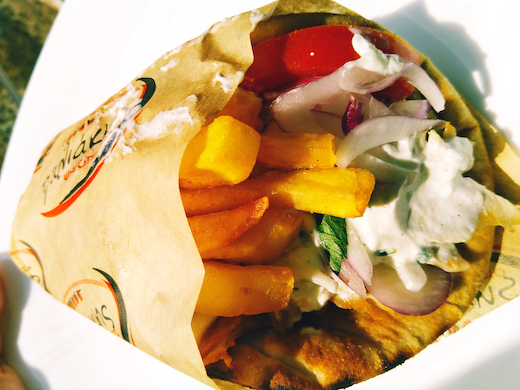A Greek Column: Picasso? Moussaka? In This Cultured Corner, You Can Have Both
Welcome to the teeming and reliably unruly Athenian neighborhood of Pagrati, where there is more to see than meets the eye.

ATHENS — A neighborhood habitué can always tell when a tourist is on the verge of desperation. The one I spotted the other day was gripping an oversize and essentially useless guidebook like a life preserver while her husband squinted at his smartphone in the uncompromising Greek sunshine, muttering something not particularly printable about Google maps.
“You guys American?” I shouted from across the street, blissfully throwing pronoun caution to the wind, as one can still do when overseas.
“Yes,” the white-haired woman answered. “Are you a guide? We are very lost. We came from the Goulandris. Are we anywhere near the Acropolis?”
“Well, you’re a little turned around,” I replied. “I can point you in the right direction, though.”
Welcome to the teeming and reliably unruly Athenian neighborhood of Pagrati, where there is more to see than meets the eye. Ever in the shadow of the Parthenon’s stolid embrace, Pagrati is putting on a new face that includes not only the requisite hipster stores and cafes but also sparkling museums that have nothing to do with ancient history. One such is the Goulandris, which pulled those wayward New Yorkers away from the more familiar Plaka and about which they raved as I led them past a bluff overlooking the Temple of Olympian Zeus, currently under renovation.

The museum of the Basil and Elise Goulandris Foundation opened in October 2019, just months before Athens went into lockdown due to the coronavirus pandemic and put a damper on the fanfare that would normally accompany the public debut of a collection of this stature. Basil Goulandris was a Greek shipping tycoon who made his fortune on the basis of his post-war purchase of 50 Liberty cargo ships the Americans built during World War II. Along with his wife, Elise, Goulandris amassed an art collection that was valued at an estimated $3 billion following their deaths. The best bits, including works by Van Gogh, Picasso, Kandinsky, Rodin, Cezanne, Monet, and other heavy hitters, are now on resplendent display in an overhauled and expanded early 20th-century townhouse in Pagrati.
It is precisely the lack of drama and absence of crowds that pulls you in, and might even cause some disorientation as you exit. No tour bus magnet, this, because the kinds of relics most people come to Athens for — ancient black-figure vases with mythological scenes, remnants of bronze helmets the hoplites wore, burly sculptures of the Greek deities — are elsewhere. Instead you will find Picasso’s riveting “Nude Woman with Raised Arms,” van Gogh’s riotously pink “Olive Picking,” and El Greco’s quietly ravishing “Veil of Saint Veronica” — an almost incandescent depiction of Jesus that is about as arresting an image as you’re likely to find in Athens.

Like most things in the Greek capital, the museum was a long time coming. When workers started digging a few blocks down the street in 1996, they stumbled upon the ruins of the lyceum where Aristotle taught, so the project was halted. The ruins are close to the probable, vanished site of the ancient sanctuary of Hercules Pancrates, the “all powerful.” That is the origin of the name Pagrati via the Pankration, an ancient form of wrestling that was practiced here and in which you could do anything to your opponent except gouge his eyes out.
Like all the best museums in this sprawling capital, the Goulandris comes with a winner of a restaurant. Many locals come just to nibble on the likes of an Andros “fourtalia” thick-style omelet with potatoes, feta cheese, and Greek herbs. Or gnocchi with beetroot cream, Andros mastic cheese sauce, broccoli, and truffle. Or a Greek-Asian fusion treat like twisted baklava with walnut and dark chocolate namelaka, peanut praline and mastic muhallebi (a kind of milk pudding).
There is a large interior courtyard insulated from the roar of traffic that invites leisurely lunches, but Pagrati is not lacking in quicker options either. Step outside the museum and into any of the bakeries on busy Eratosthenous Street and you will see for yourself.
Because it is primarily a residential neighborhood and Athenians love to eat, most of them sell not just bread and buns but also homestyle Greek cooking made for takeaway. Thus you can taste some of the best moussaka, pastitsio, herb-roasted chicken, and other staples of the Greek kitchen for a song and with no wait.
For gyros, though, just go wherever you see roasted meat rotating on a spit. One of the best spots is Paliakis Psitopoleio, or Old Grill, a hole-in-the-wall operation in the unpretty but pleasantly bohemian Varnava Square a few blocks up from the Goulandris. For about four bucks you can get a superb lunch to take in your hand as you navigate the tangle of streets, which on the southern side skirt the back end of Kalimarmaro, the Greek name for the Panathenaic Stadium that hosted the Panathenaic Games in antiquity.

Something else noteworthy happened in this neighborhood during the grim period of lockdowns: last year’s inauguration of the National Gallery on Vassileos Konstantinou Street. The completely new building houses Greek and European artworks dating between the 14th and 20th centuries. Two the star Greek painters whose works are on display are Konstantinos Parthenis, whose dreamlike post-Impressionist oeuvre reworks Byzantine and ancient Greek imagery, and Yannis Tsarouchis, the Piraeus-born modernist who painted Greek sailors and soldiers with singular flair.
This correspondent was unimpressed with the museum gift shop, but Pagrati was never about commercial sparkle. It is more like a backstage for the life of an ageless city, case in point that striking, all-marble stadium. The horseshoe-shaped structure had fallen into a state of almost complete ruin by the time it was renovated ahead of the Olympics in 1896. Today’s Athenians jog around the top of it, with Mount Lycabettus and the Acropolis looming in the background.
The Ardittou Hill rises in a green swirl above the stadium and the higher up it you stroll, the more sweeping are the views: all the way to the Saronic Gulf, where Santorini-bound cruise ships sail past the long tankers that helped build up the real fortunes in Greece. Obscured in the flowering inner-city woodland are the ruins of a temple to Tyche, the ancient goddess of fortune and urban prosperity, but I am not going to tell you exactly where. I mean, I’m one of Pagrati’s biggest fans and as such will happily point you in the right direction, but no, I am not a guide.

